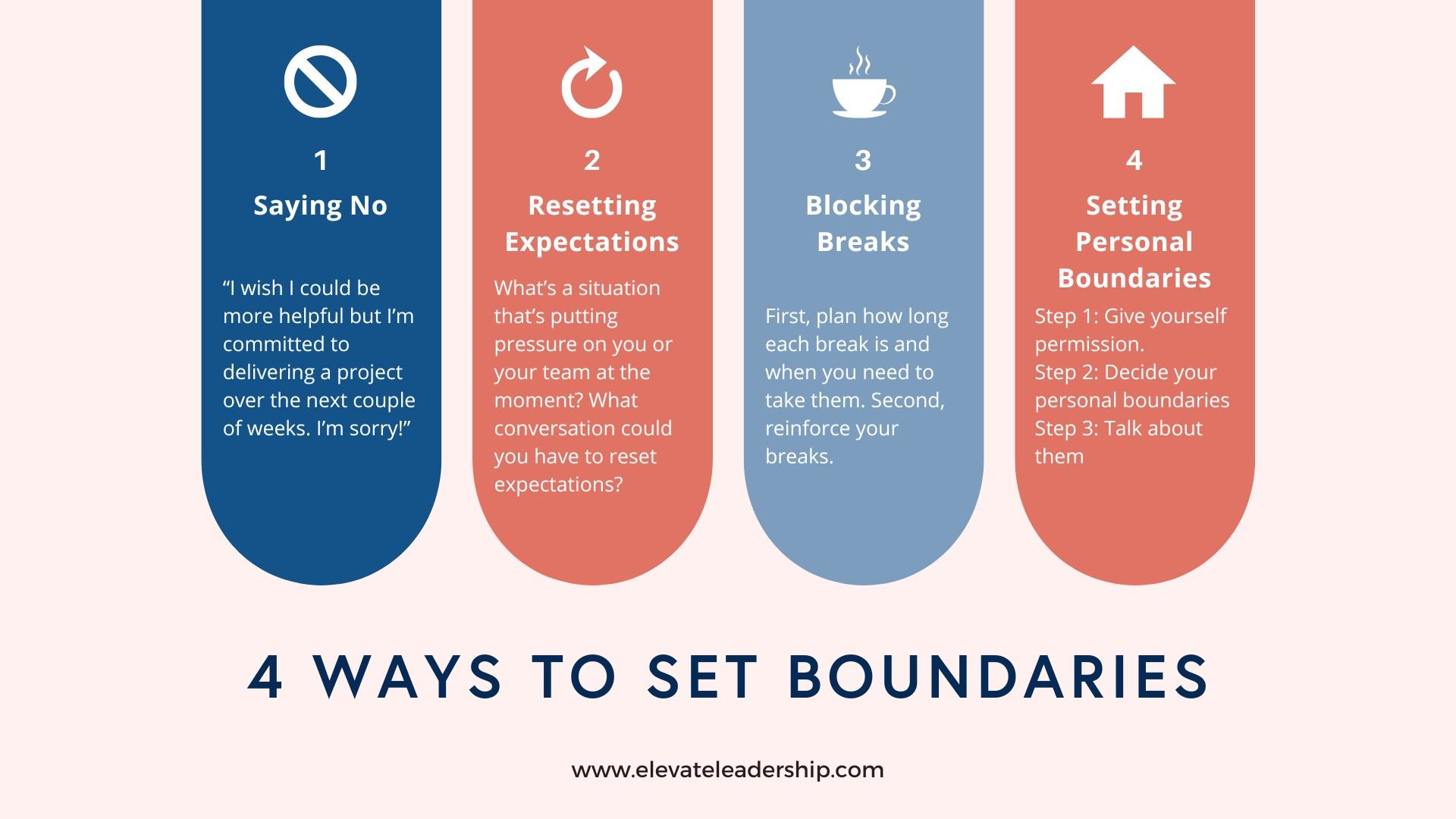How to Actually Set Boundaries At Work
Managing boundaries can be a challenging task, especially for managers who have to juggle multiple responsibilities and constantly navigate complex interpersonal dynamics. However, setting healthy boundaries is essential for maintaining well-being and creating a productive work environment.
So, don’t ever feel guilty about setting boundaries!
According to research co-written by a team of researchers at the University of Illinois, "Those who have greater boundary control over their work and personal lives were better at creating a stress buffer that helped protect them from falling into a negative-rumination trap."
Setting professional boundaries is critical for our mental health and well-being, but finding the right balance between being available to your team and maintaining your boundaries can be challenging..
I've compiled science-based advice and insights to help you navigate this tricky terrain successfully. My goal is to help you communicate and uphold your boundaries confidently, so you can create a work environment that fosters mutual respect and trust.
If you’re a People leader, share this blog with your managers, especially those who exhibit symptoms of overworking, burnout, difficulty prioritizing, and poor work-life balance.
Want to improve your people’s wellbeing and help them be their best?
Chat with our consultant to get your customized management training roadmap focused on wellbeing for free.
4 Ways to Set Boundaries and How to Make Them Work
1. Saying No
It’s hard to say no to people sometimes, especially when you want to be kind and helpful. I get it. But ask yourself, what is the cost of me saying yes to this?
Contrary to how it feels, people will actually respect you more for saying no in many cases. You are role-modeling how to focus and prioritize. You are not overpromising and dropping the ball later. It shows you respect yourself and value your time.
Let’s look at a few ways to say no more easily.
“I wish I could be more helpful but I’m committed to delivering a project over the next couple of weeks. I’m sorry!”
“As much as I hate to decline, I’m going to have to bow out of this one. I’m just keeping my head above water myself!”
“Yes, I’d like to help, but I think Taylor has more context. Would you mind checking in with them first?”
Here you're not directly saying no, but giving them another option to try first. While I wouldn't advocate passing the buck, I would use this for times when, in truth, it's not your role, and you're particularly pressed for time.
“It's only by saying no that you can concentrate on the things that are really important.”― Steve Jobs
Bonus Tip: Saying Yes with Parameters
Of course, sometimes you need to say yes - it might be your job! Let’s look at how to say yes with professional boundaries in place to help manage your time and maintain your focus:
“Yes, I’d be happy to help but I’m just focused on this task at the moment. Can you pop some time in my calendar later this afternoon to talk about it?”
You’ve said yes but in a way that you’re still in control of your schedule and how you’re prioritizing your commitments.
Here’s another way of saying yes but making a boundary clear:
“Yes, of course I’ll help - what have you tried so far to make progress?”
Here you’re setting that expectation that you expect the other person to have at least had a go in figuring it out for themselves before they come straight to you for help!
“Yes I can take this on but I am going to need to drop something to make time.” (And if the request is coming from someone who helps direct your priorities,) “What would you like me to deprioritize?”
Here you're acknowledging that you're willing to help but also making it clear that there are limitations to what you can take on.
The Science Behind Saying No
Researchers state that having a sense of internal locus of control over our own lives is one of the important conditions for mental health. A healthy sense of control comes from saying “no” without feeling guilty. At times, it’s simply wiser to take good care of yourself first, so you can in turn be better (and truer) with others.
2. Resetting Expectations
Sometimes what’s making us feel stressed is an expectation we set with someone else that needs to change. Maybe it’s something you said ‘yes’ to but wished you hadn’t.
Tip: If you need to reset expectations with your manager, you can use these tips on ‘How to Manage Up: 4 Simple Practical Tips’.
A client of mine recently promised a peer of hers that she would help edit a company-wide meeting deck but realized that it would come at the expense of not finishing her own deliverables that day. My client felt bad that she had retracted her initial offer to help, but felt better knowing that she was honoring her own commitments.
What’s a situation that’s putting pressure on you or your team at the moment?
Take a second to write it down. What conversation could you have to reset expectations? Note down what you could say. Feel doable? If so, when could you have that conversation?
You could start by saying something like “This is not an ideal situation but I set an expectation with you which I’m going to have to reset. Is now a good time to chat about it?”
Hello, World!
The Science of Resetting Expectations
When employees are put in a high-stress situation (i.e. overly-high expectations), they are at risk of moving into fight-or-flight mode. Our ability to think long term, strategize, and innovate decreases. If we stay in this mode too long, eventually, we get burned out.
Find our tips helpful but not sure how to transfer the skills to your people?
Learn how Elevate Academy creates true behavioral changes from the get-go.
3. Blocking Breaks on Your Calendar
Another way of setting and maintaining professional boundaries is blocking time in your calendar for breaks.
Research by Microsoft found that back-to-back meetings can decrease your ability to focus and engage. Without breaks, the average activity of beta waves in our brain—those associated with stress—increased over time and kept accumulating. Participants were withdrawn and less engaged in subsequent meetings.
But when participants were given a chance to rest using meditation, beta activity dropped, allowing for a “reset.” This reset meant participants started their next meeting in a more relaxed state. The antidote to meeting fatigue is simple: taking short breaks.
How do you maintain your boundaries around breaks?
First, plan how long each break is and when you need to take them. You might block 30 minutes every few hours to reset, or it might be as short as ending a 30 minute meeting 5 minutes early to make the transition to your next meeting. Small behavior changes can make a difference.
Second, reinforce your breaks. Have a conversation with your team about why you’re putting break blocks in and set the expectation that they can’t be scheduled over unless there’s an emergency. Encourage them to take a similar approach to their calendars!
4. Setting Personal Boundaries
This is an important one because it sets the tone for your team. Follow the 3 steps below to start:
Step 1: Give Yourself Permission
As a manager, you're probably used to putting others first. You might feel like you always have to be available, always have to say yes to requests, always have to go above and beyond. But that's not sustainable, and it's not healthy either.
You need to give yourself permission to prioritize your own needs and well-being, so you can be the best version of yourself for your team.
Step 2: Decide What Your Personal Boundaries Are
Take a moment now to reflect and ask yourself:
What are my personal boundaries at work?
What’s important to me?
What do I need in order to be at my best and have the energy to focus?
If you’re someone who gets cranky with no food, make sure some time for lunch is scheduled. A client of mine worked a lot in the evening, but he found that unless he set a boundary to shut down his laptop by 9:30pm, his work thoughts really affected his sleep.
As a side note, please take your paid time off! Your own burn-out will start to affect your team and you will be role-modeling how important work-life balance is.
Step 3: Talk About Your Personal Boundaries
Make sure your team knows you've been thoughtful about building personal boundaries into your week.
For example, “Yes I can meet to talk about that this afternoon! I just need to be walking out the door by 5:30pm to make it to my boxing class.”Or “Today my kids are home from school and I’d like to have lunch with them. Does 2pm work instead?”
Talking about your own boundaries helps others feel comfortable setting them for themselves, which makes setting personal boundaries part of your team’s shared culture.
Free ‘How to Set Boundaries’ Video Training
It's really important to set boundaries at work so you can take care of yourself and create a productive environment. I know it can be tough, but these tips can help you handle it like a pro!
If you find this article helpful, you can either bookmark it or watch it on our ‘How to Set Boundaries’. The video is great for people who like learning via engaging, interactive content that provides actionable, science-backed tips.
Get your 14-day free access to Elevate Academy to watch ‘How to Set Boundaries’ Video Training.
Lucy Georgiades, Co-Founder and CEO
In London and Silicon Valley, Lucy has spent over a decade coaching Founders, CEOs, executive teams and leaders of all levels. She’s spent thousands of hours helping them work through challenges, communicate effectively, achieve their goals, and lead their people. Lucy’s background is in cognitive neuropharmacology and vision and brain development, which is all about understanding the relationships between the brain and human behavior.
Lucy is an Oxford University graduate with a Bachelors and a Masters in Experimental Psychology and she specialized in neuroscience. She has diplomas with distinction in Corporate & Executive Coaching and Personal Performance Coaching from The Coaching Academy, U.K. She also has a National Diploma in Fine Art from Wimbledon School of Art & Design.






